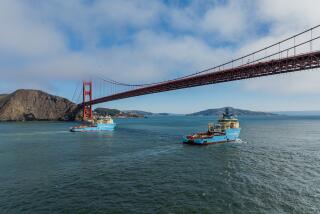The Great Pacific Garbage Patch counts 1.8 trillion pieces of trash, mostly plastic

More than 87,000 tons of ocean plastic are floating inside The Great Pacific Garbage Patch, a figure up to 16 times higher than previously estimated. This is 1.8 trillion pieces of trash, and plastic makes up 99.9% of this debris. (The Ocean Cleanup
- Share via
The Great Pacific Garbage Patch is getting greater. Twice the size of Texas, the floating mass of about 79,000 metric tons of plastic is up to 16 times larger than previously thought, according to scientists who performed an aerial survey.
The results, published Thursday in the journal Scientific Reports, reveal that this plastic blight in the Pacific Ocean is still growing at what the researchers called an “exponential” pace.
The Great Pacific Garbage Patch, or GPGP for short, is an accumulation of junk that has collected in the waters between California and Hawaii. The concentration of floating plastic in the patch ranges from tens to hundreds of kilograms per square kilometer. But much of it is hidden from the naked eye, partly because some of the plastic has been broken down into smaller and smaller bits over time. (It is not, as its name may suggest, an island.)
“It’s quite frightening,” said lead author Laurent Lebreton, an oceanographer with the Ocean Cleanup Foundation based in the Netherlands. Out in the stretch of these blue seas, we’re so far from any human activity, there’s nothing out there, and we still leave traces as a society.”
The GPGP is just one of many large garbage patches in the world’s oceans, seeded and fed by humans who manufacture and then discard plastic products.
Plastics are meant to last, and that’s great for carrying your groceries in thin bags or holding a six-pack. It’s not so great when those plastics end up in the guts of sea turtles or strangle birds.
Large or small, plastics of all sizes can harm ocean life. Recent studies show that biofouled plastic can attract fish and seabirds and end up in the food chain. While the full effects of this aren’t yet known, scientists worry that this can lead to malnutrition and other problems.
Researchers have tried to get a handle on the GPGP by dragging nets through parts of the patch and sampling the plastic they find. But this only gives them a partial view. For one thing, a team of boats can only see so much. For another, the mouths of the samplers they use are often too small to catch larger pieces of debris.
Lebreton and his colleagues decided a bird’s-eye view would help. The scientist recalled how it felt to fly low over this expanse of ocean, so far from human civilization, and still see its mark.
“It is a deep blue ocean, the water is super clear, and you just see all those things just floating around,” he said. “It just feels so random.”
In addition to their aerial surveys, the team also dispatched boats to sample the debris and bring it back to shore for analysis.
The researchers split the plastic they collected into four size categories: microplastic (0.05 to 0.5 centimeters), mesoplastic (0.5 to 5 cm), macroplastic (5 to 50 cm) and megaplastic (bigger than 50 cm).
Previous accounts of the debris have focused on the amount of microplastics in the Great Pacific Garbage Patch. In this analysis, microplastics did make up 94% of the estimated 1.8 trillion pieces in the patch, but they only accounted for 8% of the total mass.
More than three-quarters of the junk actually came from larger fragments: mesoplastic and macroplastic.
Part of the reason that larger plastics outweighed the other categories was the preponderance of fishing nets, which accounted for 46% of the garbage patch’s mass. Fishing nets are made to be durable, and when they float through the ocean, they entangle and kill animals in their path.
Fifty plastic items had readable production dates: One from 1977, seven from the 1980s, 17 from the 1990s, 24 from the 2000s and one from 2010. (It’s not clear how long these items were actually in the water, Lebreton pointed out.) Some 386 pieces had words from nine different languages — a third were in Japanese and a third were in Chinese.
The researchers think some of the patch’s recent growth may have been fueled by the 2011 Tohoku tsunami, which reportedly washed 4.5 million metric tons of debris into the sea. Scientists estimate that more than 30% of it could have been moved across the ocean surface.
The plastic that lived in the patch also shared certain characteristics, such as a small surface-to-volume ratio. Plastics with high surface-to-volume ratios, such as sheets and films, were probably biofouled or broken down into smaller fragments that did make it into the patch.
None of this, of course, counts all the plastics that may have sunk to the bottom of the ocean.
“Levels of plastic pollution in deep water layers and seafloor below the GPGP remain unknown,” the study authors wrote.
That’s the next step, Lebreton said — to measure how much plastic lies far below the surface.
To read this article in Spanish click here
Follow @aminawrite on Twitter for more science news and “like” Los Angeles Times Science & Health on Facebook.
MORE IN SCIENCE
Oceans on ancient Mars may have got an assist from volcanoes
Modified Pap tests can show early warning signs of other gynecological cancers
To avoid germs on an airplane, consider booking a window seat
UPDATES:
10:25 a.m.: This story has been updated with additional details and comment from Laurent Lebreton.
This story was originally published at 7:00 a.m.







